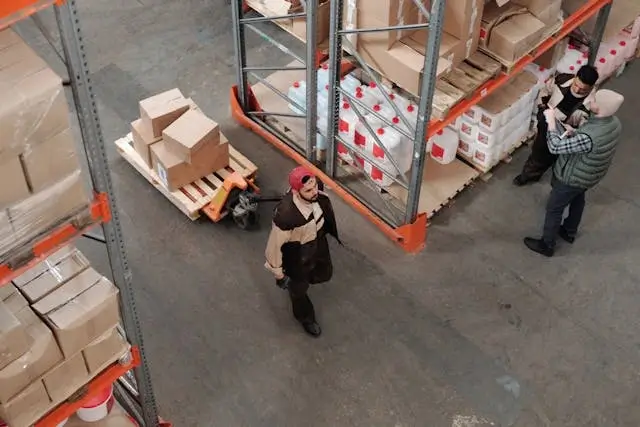
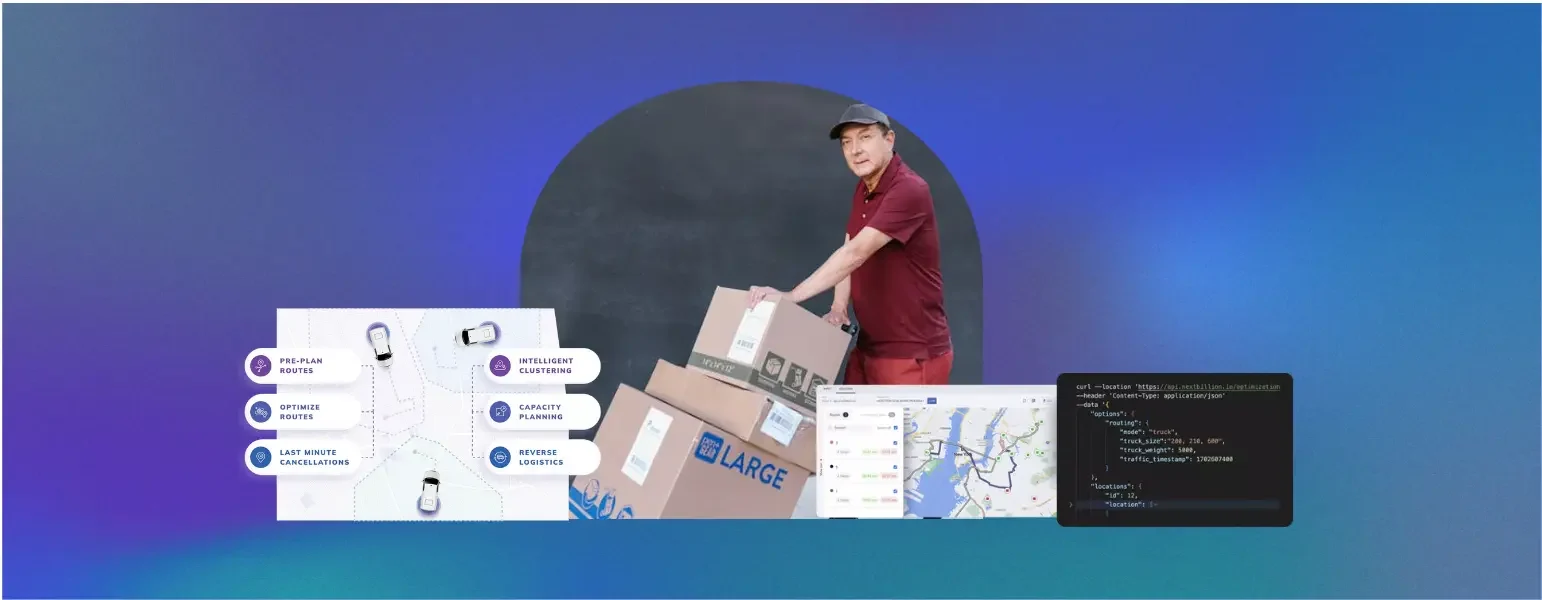
- BLOG
Last-Mile Routing Fails That Bleed Profit and How Smart Couriers Fix Them
Published: November 19, 2025
Route Optimization API
Optimize routing, task allocation and dispatch
Distance Matrix API
Calculate accurate ETAs, distances and directions
Directions API
Compute routes between two locations
Driver Assignment API
Assign the best driver for every order
Routing & Dispatch App
Plan optimized routes with 50+ Constraints
Product Demos
See NextBillion.ai APIs & SDKs In action
AI Route Optimization
Learns from Your Fleet’s Past Performance
Platform Overview
Learn about how Nextbillion.ai's platform is designed
Road Editor App
Private Routing Preferences For Custom Routing
On-Premise Deployments
Take Full Control of Your Maps and Routing
Trucking
Get regulation-compliant truck routes
Fleet Management
Solve fleet tracking, routing and navigation
Middle Mile Delivery
Optimized supply chain routes
Construction
Routes for Construction Material Delivery
Oil & Gas
Safe & Compliant Routing
Food & Beverage
Plan deliveries of refrigerated goods with regular shipments
Table of Contents

The last mile is an important component of any successful delivery operation. A product travels from a distribution centre to the customer’s door in this last stage of the process. Although it is the shortest stage of the delivery cycle, it is frequently the most costly, uncertain, and operationally taxing.
Nearly half of all shipping expenses for the majority of logistics companies are related to last-mile delivery. This implies that even minor inefficiencies in scheduling, vehicle usage, or route planning can rapidly reduce margins. In isolation, a single delayed delivery or needless diversion might not seem like much, but when hundreds of vehicles and thousands of routes are involved every day, the financial impact becomes enormous.
In this article, we’ll explore the most common last-mile routing failures that quietly bleed profit and uncover how forward-thinking delivery businesses are fixing them using intelligent, data-driven tools.
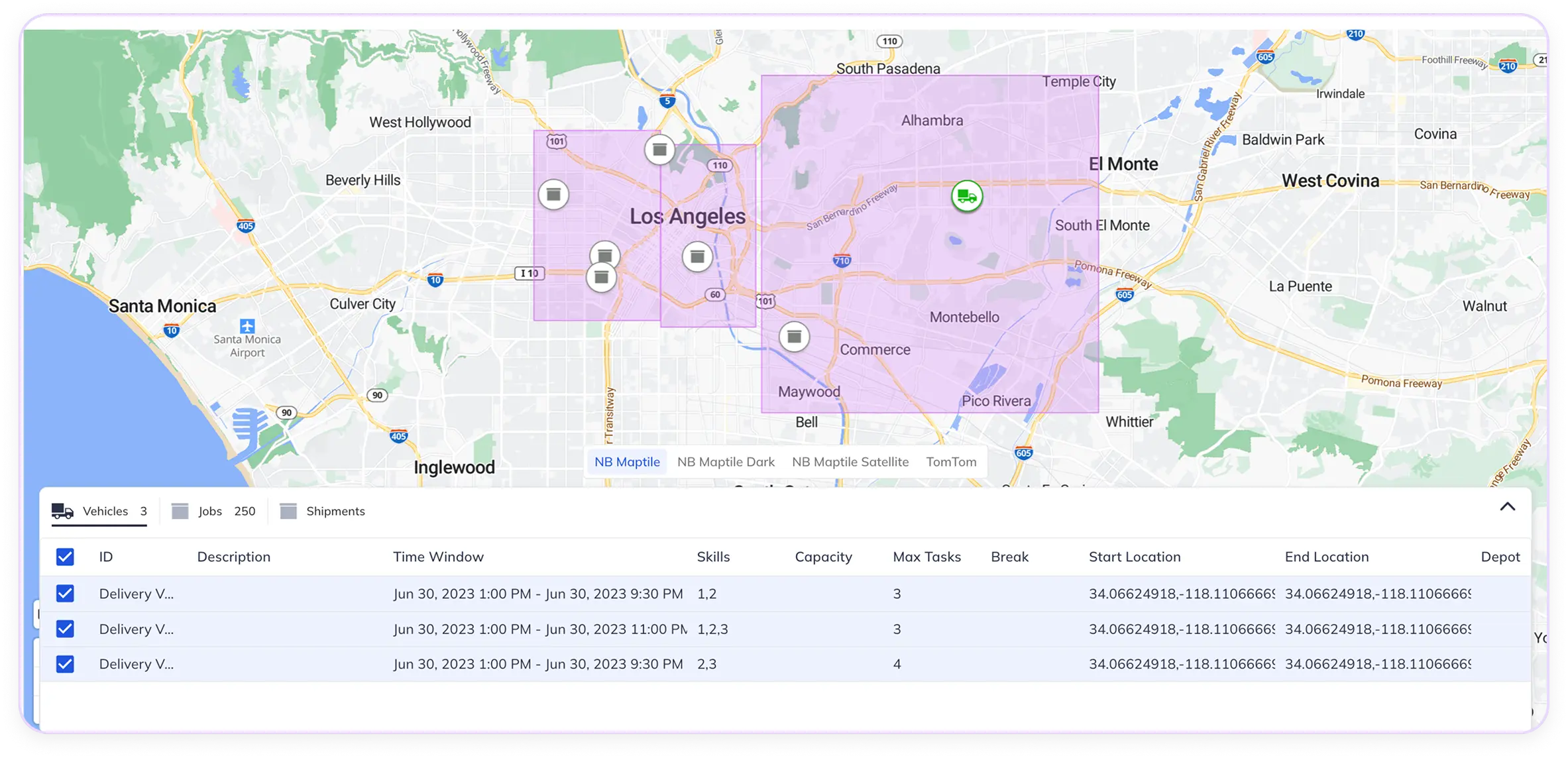
The process of figuring out the best routes for delivery trucks to take in order to go to several locations within a specified service area is the fundamental of last-mile routing. In general, this might seem straightforward, but the practical aspects are much more complex.
The last-mile delivery deals with high-density urban traffic, shifting delivery priorities, and continuously shifting conditions, from weather changes to client availability in contrast to long-haul or mid-mile delivery, where routes are more predictable. Even the most carefully designed delivery routes can be affected by any of these factors.
The complexity also stems from how many factors need to be optimised simultaneously:
Conventional routing techniques that depend on manual scheduling, static maps, or basic GPS navigation are no longer adequate. The dynamic nature of last-mile logistics is not taken into consideration. Because of this, businesses are increasingly using AI-powered routing solutions that can simulate various routing scenarios, analyse massive information in real-time, and suggest the most efficient and timely routes.
To put it briefly, last-mile routing is about developing a system that can react sensibly to ongoing change rather than only determining the shortest route.
Even the most experienced logistics operations can fall victim to recurring routing pitfalls that quietly eat into profit margins. Below are some of the most common and costly last-mile routing failures:
All these failures add to the increasing costs of operation as well as lower quality of services, thereby compromising the brand’s reliability in the long run.
The inefficiency of routing does not occur in a vacuum; it has a trickle effect that affects various aspects of a company. The operational cost is the shortest-term, but the long-term impact can strike on reputation, scalability and profitability.
Rising Operational Costs
Each additional mile travelled or minute wasted consumes more fuel and man-hours. Inefficient routing may add up to 25-30 per cent a year to the costs of the last miles, when multiplied across fleets and delivery zones.
Missed Delivery Windows
Poor routing causes uneven arrival times, leading to missed time slots and even failed deliveries. In the case of e-commerce and food & beverage businesses, this translates into refunds, returns, and declining customer satisfaction ratings.
Low productivity of Drivers
Fatigue and frustration are the consequences of drivers wasting too many hours on the road, taking inefficiently optimised routes. The high turnover rates of drivers contribute to the cost of recruitment and training, which makes it even more resource-intensive.
Inaccurate Demand Forecasting
Poor information due to unplanned routes complicates the capacity of businesses to be able to predict demand. Capacity planning and inventory management are poor without reliable data inputs.
Damaged Brand Reputation
The current generation of consumers is fast, precise, and transparent. Regular failure to deliver not only loses customers but also damages the image of a brand in an extremely competitive market.
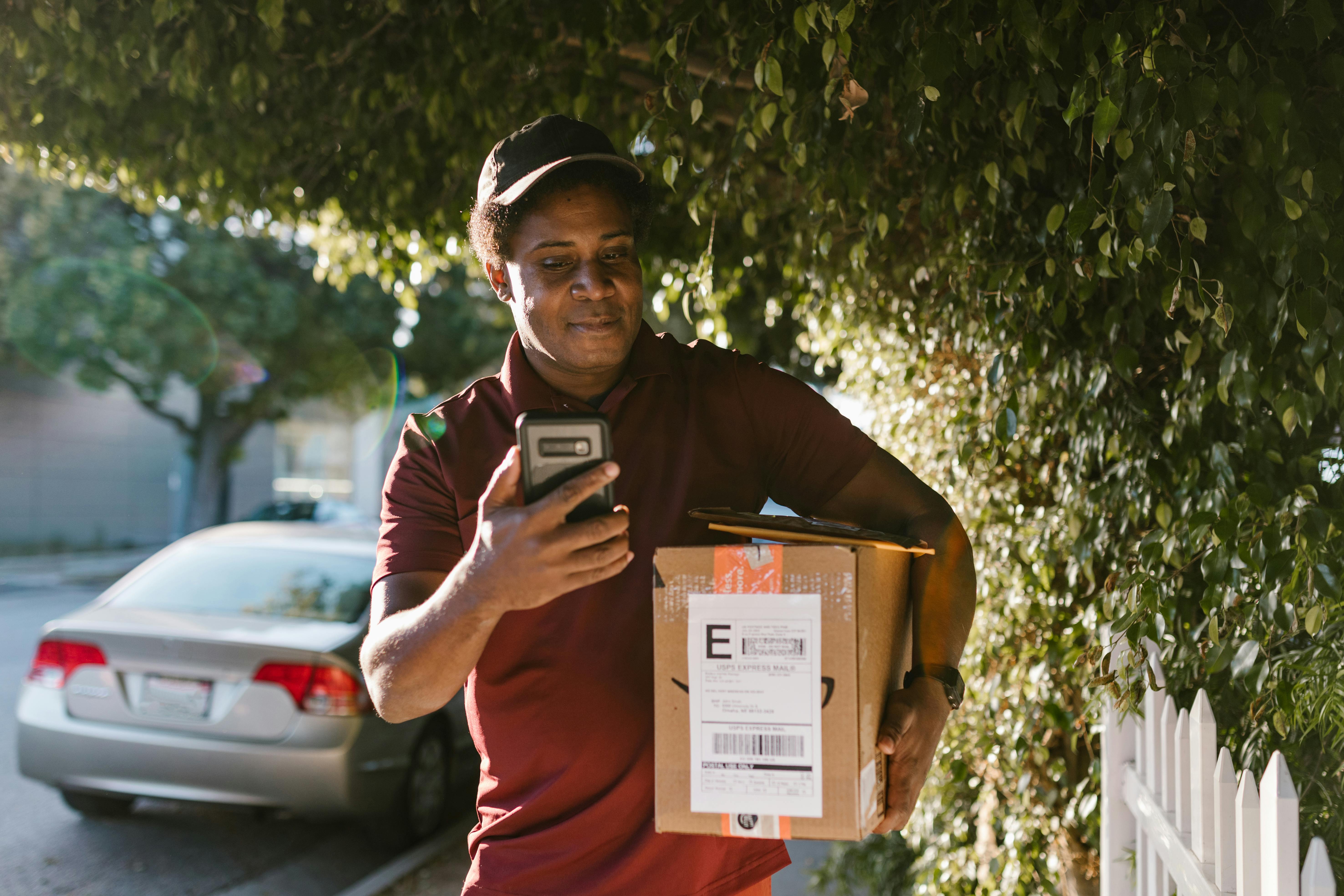
The Smart couriers have transformed the last-mile delivery by moving away the reactive operations to predictive, data-driven logistics. They do not make every decision count in delivering by using manual decision-making or old routing software, but rather by using AI, real-time analytics, and automation.
Here’s what sets them apart:
The economic implications are obvious: inefficient routing is not only a technical issue, but is also a strategic risk. Companies that neglect it may lose their profitability and client loyalty. However, smart couriers are making this challenge an opportunity; they are using AI-based routing intelligence to optimise each delivery leg, both during planning and execution.
Smart couriers are dependent on constant feeds of data, whether it is GPS positioning and traffic information, customer actions and shipping history. This information is the basis of correct forecasts and dynamic changes of routes. They do not wait till something disruptive happens, but foresee this and adjust to it.
Smart couriers also apply live routing engines in contrast with traditional dispatch systems, which calculate variables in real time. As the traffic increases, the weather alters, or a delivery is postponed, the system will automatically recalculate the most efficient option: minimum delay and maximum productivity.
It is not about separate tools in modern logistics. Smart couriers encompass all the capabilities of routing, dispatch, customer communication and performance monitoring capabilities in a single ecosystem. The seamless flow of data can be achieved through this integration, which enhances decision-making and accountability.
The most successful delivery teams do not plan once a day, but daily. They re-optimise routes in the middle of the journey to consider changing conditions of deliveries using dynamic reoptimization. This flexibility makes drivers efficient, and all routes are cost-effective.
Being efficient does not mean success. Smart couriers strike a balance between cost optimisation and very good customer experiences. They also give correct ETAs, real-time tracking and stable delivery service performance, which creates customer confidence, which in the end results in repeat business and brand loyalty.
In essence, the distinction between smart couriers is not only technological but also a sense of mind, a desire to be smart in their operations, flexible, and in a constant state of improvement.
Common Last-Mile Routing Fail | Resulting Business Impact | How Smart Couriers Fix It |
Inefficient Route Planning | Excess fuel use, longer delivery time, higher costs | AI-based dynamic route optimisation using real-time data |
Poor Capacity Utilisation | Half-empty or overloaded vehicles, wasted trips, asset strain | Capacity-aware load planning that matches orders to the right vehicle |
Lack of Real-Time Visibility | Missed SLAs, cascading delays, unhappy customers | Live tracking + automatic rerouting to prevent disruption spread |
Poor Clustering & Zoning | Unnecessary cross-zone travel, driver fatigue, slow routes | Smart geo-clustering to group deliveries by proximity and demand |
Inflexible Scheduling | Failure to adapt to late customers, urgent orders, breakdowns | Dynamic scheduling + auto-reassignment based on live conditions |
Manual / Static Route Systems | High operational cost, planning delays, human errors | Automated routing engines powered by AI & predictive analytics |
Unreliable ETAs & Communication | Lower customer trust, returns, refunds | Accurate ETAs + customer-facing real-time notifications |
Good drivers are not enough to turn chaos into organised precision at the last-mile; a strong routing ecosystem that is adaptive, learns and optimises in real-time is required. That is what Nextbillion.ai enters with.
Nextbillion.ai integrates geospatial intelligence, AI-based route planning, and real-time flexibility to enable businesses in the Food and Beverage, E-commerce, Construction, and Oil and Gas sectors to be more efficient, reliable, and profitable.
Let us take a peek into the toolkit of the smart courier and observe how every element has been used to achieve operational excellence.
All successful delivery days begin with a plan; however, not all plans are made equal. Conventional route planning solutions use either fixed maps or templates that are unable to cope with the dynamism of the real logistics environment. The Advanced Route Planning of Nextbillion.ai does that.
It helps logistics managers to create highly customised, data-driven and operationally efficient routes. It plans the most optimal path of stops using advanced geospatial data, traffic analytics, and AI-driven algorithms, which reduce the distance and maximise productivity.
Key Benefits:
In such industries as E-commerce, when the quantity of deliveries may vary every day, or when the routes have to be used by heavy machinery and access is restricted in construction areas, such accuracy of planning makes sure that the working process begins to be good and remains stable.
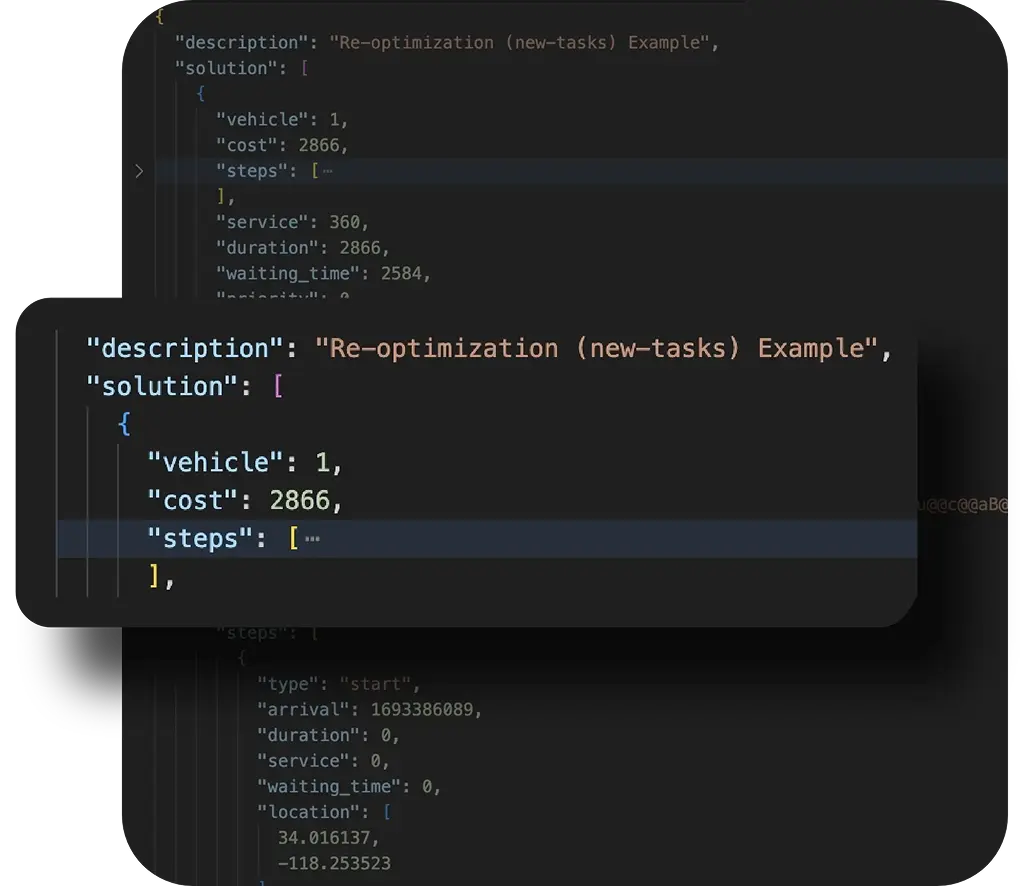
Despite the best planning, things often backfire: a traffic jam just as your route is almost complete, a customer turns up late, a vehicle malfunction happens and the route gets delayed. Dynamic Reoptimization comes in at that point.
The system of Nextbillion constantly tracks live delivery data and automatically calculates routes once the conditions vary. The network is dynamic in that it automatically rearranges routes. Instead of waiting for dispatchers to do it manually, the rerouting of drivers, reassigning deliveries, and updating ETAs are done in real time.
What It Does Differently:
Dynamic reoptimization does not waste a mile or a minute in Food & Beverage delivery, where freshness and timing matter and in E-commerce, where customers expect delivery within minutes. In industries such as Construction and Oil & Gas, where the logistical delay can bring the whole business activity to its knees, this aspect protects productivity and profitability.
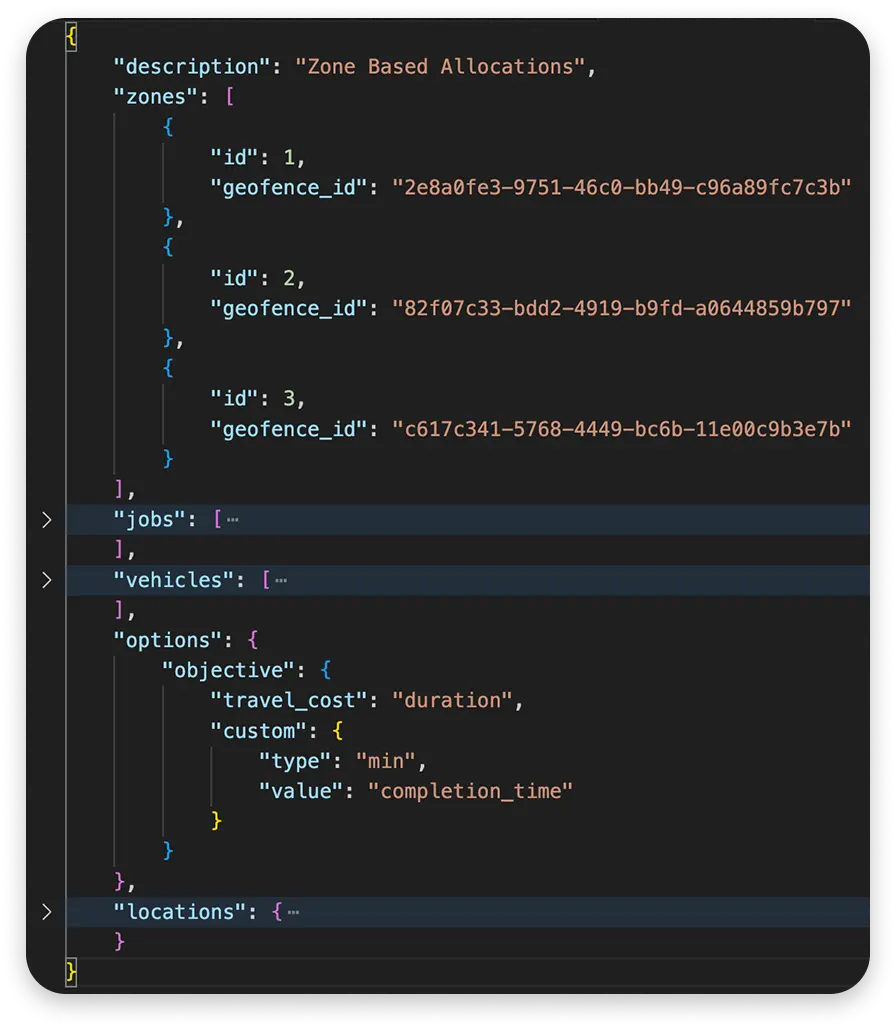
Smart routing does not necessarily refer to the way the path is undertaken by the driver, but it also concerns the design of delivery regions. Ineffective zoning of areas causes unnecessary travelling, uneven workload, and unreliable delivery. The Intelligent Clustering & Zoning of Nextbillion.ai resolves it with the help of spatial AI analysis.
The system divides the delivery points according to geographic proximity, volume of orders and time so that zoning will have a high driver efficiency and minimum cross area occupation.
How It Delivers Value:
For Construction and Oil & Gas operations, where delivery sites can be remote or constantly shifting, intelligent zoning helps allocate resources effectively and maintain a timely material supply.
This approach not only enhances fleet efficiency but also supports strategic growth planning by identifying underperforming zones and emerging high-demand areas.
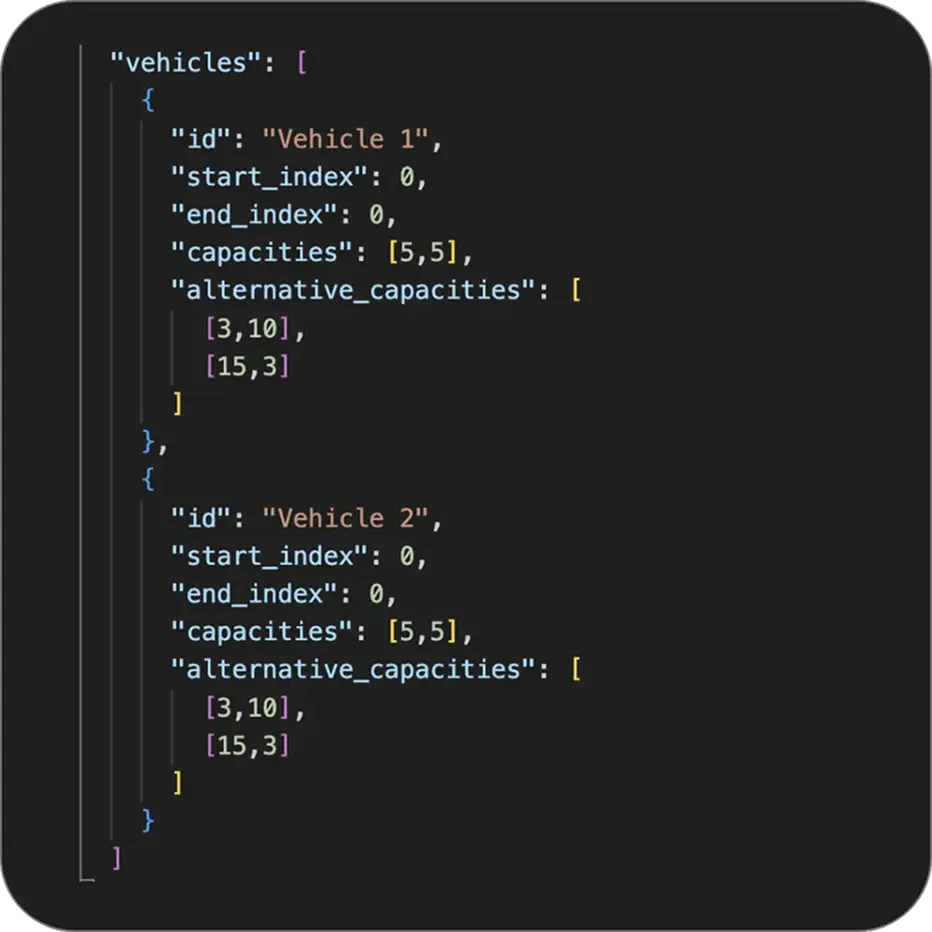
Poor planning leads to one of the most frequent last-mile issues, namely improper capacity utilisation. Cargo that is either half-empty or overloaded. Capacity-Aware Planning of Nextbillion offers full utilisation of all vehicles.
This system measures the sizes of the vehicles, the weight capacity of cargo, and delivery time to allocate loads in the best way possible. It is best to match orders with appropriate vehicles and take into account capacity limitations.
Advantages Include:
Capacity-aware planning eliminates time and money-wasting inefficiencies in E-commerce, where the volume of a shipment can range, single parcels to bulk, and in Oil and Gas or Construction, where compliance and safety are paramount concerns.
This degree of control would turn logistics into a game of guessing into an operation that is predictable and supported by data, or information. It means that there would not be any mile of delivery that is not directly tied to profit.
When companies switch to the use of manual routing to the use of intelligent last-mile optimisation, the return on investment is nearly immediate. Smarter routing cost savings represent only a part of the deal, as it helps in increasing the revenue potential because it can make more deliveries on a given shift, reduce customer complaints, and result in efficient resource allocation.
1. Lower Operational Costs
Dynamic routing reduces unnecessary miles and idle time, and this directly saves on fuel consumption, which in most cases is 20-30% of the overall logistics expenses.
2. Better On-Time Vehicle Delivery Rates
Under real-time optimisation, couriers are able to keep the accuracy of delivery even when the conditions are unpredictable. An enhanced on-time performance increases customer trust, particularly when dealing with fast-moving sectors such as food delivery and e-commerce.
3. Better Fleet Utilisation
Capacity-aware planning and clustering will make sure that no vehicles will run empty or loaded. This enhances the efficiency of assets, the life span of the fleet is extended, and there is less wastage of resources on maintenance.
4. Reduced Carbon Footprint
The fewer the miles covered, the less fuel combusted. More intelligent routing is also more sustainable, which aligns with the current ESG agenda, an important consideration for many companies in the U.S.
5. Enhanced Customer Experience
Timely deliveries, supported by open communication, make the brand more reliable and keep customers who play a crucial role in achieving long-term profitability.
Logistics companies that implement advanced routing solutions will receive up to 25% operational efficiency gains and last-mile delivery cost reduction by 20% according to industry insights. This not only cuts the costs, but it is a performance-based change.
The trend of last-mile delivery is quickly shifting towards a more predictive, autonomous and sustainable way of operation. Previously, a manual and reactive process was turned into a completely data-driven environment.
In brief, the future of last-mile logistics will be at the cross-section of intelligence, automation, and sustainability, where all routes will be optimised to serve not only profit, but a purpose too.
Before adopting smart routing, most logistics teams still rely on outdated, manual, or static delivery systems that can’t keep up with real-world conditions. The table below compares legacy routing technology with modern AI-powered systems used by smart couriers.
Traditional / Legacy Routing Tech | Smart AI-Powered Routing Systems |
Manual route planning using static maps | Automated route optimisation using real-time geospatial data |
Fixed routes and fixed schedules | Dynamic routing that adapts to traffic, delays, and new orders |
Basic GPS navigation with no decision logic | AI engine that predicts the best route for every stop |
No live reoptimization once the route is planned | Continuous reoptimization during the delivery journey |
Limited or inaccurate ETA calculation | Real-time ETA updates using live traffic and machine learning |
Vehicle capacity handled manually | Capacity-aware load planning based on weight, volume, and fleet type |
Separate tools for routing, dispatch, and customer updates | Integrated ecosystem for routing, tracking, and communication |
Reactive operations after a delay occurs | Predictive systems that anticipate and prevent disruptions |
Heavy human dependency and frequent planning errors | Automation-first routing with scalable, data-backed decisions |
No analytics or demand forecasting | AI insights for performance tracking, demand prediction, and cost control |
There is no place for inefficiency in the delivery environment of today. Every misallocated route, every extra mile, and every delay subtly reduces profitability. However, courier companies that view last-mile logistics as a strategic opportunity for innovation rather than a cost centre are the ones that prosper.
Businesses may change their delivery operations from reactive to predictive by implementing cutting-edge technologies like Nextbillion.ai’s adaptive routing package, which enables them to achieve accuracy, agility, and profitability at scale. From the freshness of food and beverages to the speed of e-commerce to the coordination of building sites, intelligent couriers are already establishing new standards for delivery excellence.
Your distribution network turns into a competitive advantage with Nextbillion.ai. Their AI-powered solutions, which range from capacity-aware logistics and intelligent clustering to sophisticated route planning and dynamic reoptimization, are made to cut down on inefficiencies, increase profits, and satisfy customers at every turn.
Since smart routing isn’t optional in today’s world, it’s essential. Nextbillion.ai provides you with the expertise to transform last-mile chaos into a streamlined, profit-generating system, whether you’re managing food, e-commerce, or industrial logistics.
Common last-mile delivery inefficiencies are referred to as the “last mile problem.” A few of the factors that contribute to the last-mile difficulty are short delivery times, same-day deliveries, fuel prices, last-minute route adjustments, unsuccessful deliveries, and consumer expectations.
The last-mile issue can be resolved by streamlining delivery routes, modernising technology, purchasing a high-quality real-time delivery tracking system, and guaranteeing transparency through regular customer correspondence.
Businesses must concentrate on crucial tactics, including route optimisation, utilising technology, increasing sustainability, and boosting visibility to effectively manage last-mile logistics. As e-commerce has grown and customer expectations have changed, the last-mile delivery business in India has experienced significant expansion.
The software smoothly manages both pre-scheduled delivery and instant orders by optimising mixed time models. It guarantees that urgent orders are given priority without interfering with scheduled routes.
Orders are automatically routed to the most effective hub or micro-fulfilment centre via the platform, which also allows cross-docking, pool distribution, and multi-depot route design. This lowers empty miles, speeds up deliveries, and distributes responsibilities throughout facilities.
Bhavisha Bhatia is a Computer Science graduate with a passion for writing technical blogs that make complex technical concepts engaging and easy to understand. She is intrigued by the technological developments shaping the course of the world and the beautiful nature around us.